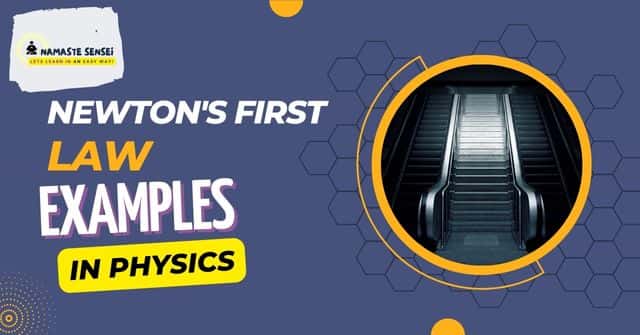Examples Of Newton’s First Law Of Motion In Daily Life
Here are the top 7 examples of Newton’s First Law of Motion In Physics & Everyday Life.
-
Vehicle Braking
-
Hammer Strike
-
Jumping On Trampoline
-
Jumping from Moving Boat To Water
-
Elevator Ride
-
Escalator Ride
-
Moving Walkways
Newton’s First Law of Motion, also known as the Law of Inertia, is one of the most important concepts in Physics. It states that an object at rest will stay at rest, and an object in motion will stay in motion unless acted upon by an external force.
In this blog post, we will be discussing 7 practical examples of Newton’s First Law of Motion that you can observe in everyday life.
But before you read any further, it might be a good idea to briefly understand what is the Newton’s First Law of Motion In Physics. It will help you to understand the examples better. If you are already familiar with the concept, you can skip it by clicking on the link below.
What Is Newton’s First Law of Motion In Physics?
Definition: Newton’s first law of motion, also known as the law of inertia, states that an object at rest will stay at rest, and an object in motion will stay in motion with a constant velocity unless acted upon by an external force.
- This law is often summarized as “an object will continue in its state of motion or rest unless acted upon by a net external force.”
- In simpler terms, if no external force acts on an object, it will either remain stationary or continue to move in a straight line at a constant speed. The first law essentially describes the natural tendency of objects to resist changes in their motion.
This principle can be observed in everyday life.
For example, when a car suddenly brakes, the passengers lurch forward due to their own inertia. Similarly, when a moving bus comes to a sudden stop, standing passengers may lose their balance and stumble forward. In both cases, the individuals’ initial state of motion (or rest) is interrupted by an external force, leading to a change in their velocity.
Newton’s first law laid the foundation for understanding the concept of inertia and the behavior of objects in the absence of external influences.
Now let’s dive into the 7 examples of Newton’s First Law of Motion in real life.
Examples of Newton’s First Law of motion In Physics & Daily Life Explained
I am sure that the concept of the Newton’s first law is clear to you now. If not, you can comment below. Let us now move on to 7 examples of Newton’s first law of motion in physics & in real life.
Examples Of Newton’s First Law Of Motion
-
Vehicle Braking:

When a vehicle suddenly brakes, the passengers inside the vehicle tend to lurch forward. This can be explained by Newton’s first law of motion, which states that an object at rest will stay at rest, and an object in motion will stay in motion with a constant velocity unless acted upon by an external force.
Here’s how Newton’s first law applies step by step:
-
Initial State: The vehicle and its occupants are in motion, moving forward at a certain velocity.
-
Braking Force: The driver applies the brakes, exerting a force on the vehicle in the opposite direction of its motion.
-
Inertia: According to Newton’s first law, the passengers inside the vehicle will resist changes to their state of motion due to their inertia. Inertia is the tendency of an object to resist changes in its velocity.
-
Passenger Inertia: As the vehicle decelerates, the passengers’ bodies want to maintain their forward motion due to their inertia. Therefore, they continue moving forward, even though the vehicle is slowing down.
-
External Force: Eventually, the passengers’ forward motion is stopped by an external force. This force can be the seatbelt, the dashboard, or the passengers’ own effort to brace themselves.
-
Change in Motion: Once the external force stops the passengers’ forward motion, they come to a rest relative to the vehicle or may move backward slightly, depending on the force exerted.
-
Hammer Strike:

When you strike a nail with a hammer, the hammerhead moves forward to hit the nail. But after the impact, the hammerhead bounces back slightly. This happens because the hammerhead wants to keep moving forward due to its inertia, even though the nail has stopped it.
In simple terms:
-
The hammer moves forward to hit the nail.
-
The hammer wants to keep moving forward because of its inertia.
-
So, even after hitting the nail, the hammerhead bounces back slightly.
This bouncing back is due to Newton’s first law of motion, which says that objects like the hammerhead tend to keep moving in the same direction unless acted upon by an external force.
-
Jumping on a Trampoline:

When you jump on a trampoline, you’re able to bounce up in the air. This happens because the trampoline’s surface is elastic and exerts a force that pushes you upward when you land on it.
In simple terms:
-
When you jump on a trampoline, the trampoline’s surface pushes you upward.
-
This push from the trampoline makes you bounce up in the air.
This bouncing effect is possible because of Newton’s first law of motion, which states that objects at rest tend to stay at rest unless acted upon by an external force. In this case, the trampoline provides the external force that propels you upward, allowing you to experience the fun and exhilaration of jumping on a trampoline.
- Jumping from Moving Boat in Water:
When you jump from a moving boat into the water, your body continues moving forward in the same direction as the boat for a brief moment before slowing down and eventually coming to a stop in the water.
In simple terms:
-
When you jump from a moving boat, your body wants to keep moving forward due to its inertia.
-
So, even after leaving the boat, you continue moving forward in the same direction for a short time before slowing down in the water.
This phenomenon occurs because of Newton’s first law of motion, which states that objects in motion tend to stay in motion with the same velocity and direction unless acted upon by an external force. In this case, your body’s inertia causes it to momentarily maintain the boat’s forward motion until the water and resistance slow you down.
- Elevator Ride:

When you are inside an elevator and it starts moving upward or downward, you may feel a slight sensation of either getting heavier or lighter.
In simple terms:
-
When the elevator starts moving, you may feel either heavier or lighter.
This sensation occurs because of Newton’s first law of motion. Your body wants to maintain its state of motion (either at rest or in motion) due to inertia. As the elevator accelerates, your body tends to resist changes in its motion, leading to the feeling of either increased weight (heavier) or a momentary feeling of weightlessness (lighter) during the elevator ride.
- Escalator Ride:

When you step onto a moving escalator, your body is initially at rest. However, the escalator’s continuous motion provides the external force needed to propel your body along with it. The escalator’s steps are constantly moving either upward or downward, and when you step onto them, you start moving with them. This allows you to effortlessly ascend or descend the escalator without needing to exert much effort of your own. The escalator’s motion acts as the external force that overcomes your body’s inertia, enabling you to move smoothly and comfortably with the escalator as it carries you to your desired floor.
- Moving Walkways

Moving walkways, also known as travelators or moving sidewalks, are a convenient feature found in many airports, train stations, and large public spaces. They are designed to assist people in traversing long distances with minimal effort.
When you step onto a moving walkway, it carries you forward at a steady pace. This is made possible by the continuous motion of the walkway’s belt, which propels you along its surface. As you step onto the moving walkway, your body is initially at rest, and according to Newton’s first law, it tends to remain at rest. However, the external force provided by the moving walkway overcomes your body’s inertia and initiates your motion forward.
References
- Physics Classroom – Newton’s First Law
This lesson focuses on explaining and exploring Newton’s First Law, which is also known as the law of inertia.
You have finished the complete article related to 7 examples of Newton’s first law of motion in physics & in daily life. If you have any doubts or queries, feel free to comment below. We will respond as soon as possible.
Or Email Us At [email protected]

